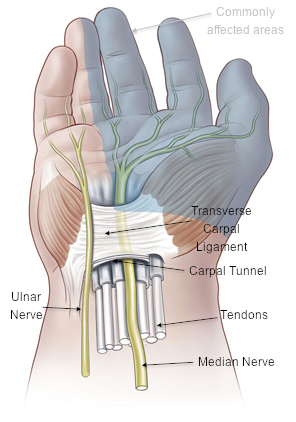Carpal Tunnel Syndrome
The carpal tunnel is located at the base of the palm of the hand.
The Median Nerve runs through the carpal tunnel. When the carpal tunnel is narrowed between the thick carpal ligament and the underlying carpal bones, the median nerve becomes compressed, and this results in nerve dysfunction.
The most common cause of carpal tunnel syndrome is pregnancy, and the symptoms usually settle after delivery of the baby. In most other people, the cause of carpal tunnel syndrome is unknown. However, there are some well known conditions that are associated with a greater risk of developing carpal tunnel syndrome, including kidney disease, diabetes, rheumatoid arthritis, thyroid disease and fluid retention.

The symptoms of carpal tunnel syndrome include
The sensory symptoms (pain, tingling, pins & needles, numbness) usually affect the thumb, index and middle finger; in some people, all fingers develop such symptoms.
In many people, carpal tunnel symptoms occur at night, waking them from sleep. When this occurs, many people describe the need to shake the hand to settle the symptoms.
In others, symptoms occur during the day, especially with certain activities, such as driving the car, or typing on a keyboard. In some, there is no pattern to the timing of symptoms.
Diagnosis of carpal tunnel syndrome is often straightforward, but in some cases it may be quite difficult and complicated because other conditions may mimic the symptoms of carpal tunnel syndrome. Such conditions include cervical disc disease, ulnar neuropathy, peripheral neuropathy and arthropathy.
This illustration reproduced with permission from the Peripheral Nerve Surgery pamphlet (RACS, NSA, Mi-tec Medical Publishing). The complete pamphlet is available from your surgeon.
- pain - in the hand, fingers, wrist, forearm
- numbness - usually in the fingers
- weakness - particularly of the thumb
The sensory symptoms (pain, tingling, pins & needles, numbness) usually affect the thumb, index and middle finger; in some people, all fingers develop such symptoms.
In many people, carpal tunnel symptoms occur at night, waking them from sleep. When this occurs, many people describe the need to shake the hand to settle the symptoms.
In others, symptoms occur during the day, especially with certain activities, such as driving the car, or typing on a keyboard. In some, there is no pattern to the timing of symptoms.
Diagnosis of carpal tunnel syndrome is often straightforward, but in some cases it may be quite difficult and complicated because other conditions may mimic the symptoms of carpal tunnel syndrome. Such conditions include cervical disc disease, ulnar neuropathy, peripheral neuropathy and arthropathy.
This illustration reproduced with permission from the Peripheral Nerve Surgery pamphlet (RACS, NSA, Mi-tec Medical Publishing). The complete pamphlet is available from your surgeon.
To confirm the diagnosis, in every case an electrical test should be performed, called nerve conduction study (NCS) and electromyography (EMG).
Treatment depends on the severity of the symptoms, the duration and any underlying cause.
In pregnancy, waiting until delivery of the baby is all that is required.
In people with mild sensory symptoms at night, trial of a wrist splint is often useful.
If the symptoms are severe, or there is weakness of the thumb, or wasting of the muscle at the base of the thumb, then surgical treatment is required.
Surgery involves dividing the thick carpal ligament. This is best done by making a 2-3cm cut over the palm of the hand, dividing the carpal ligament, and freeing the underlying median nerve. This “open” technique is superior to the endoscopic technique because it is safer and has better long term results.
Prof Davis will often refer patients for a course of formal hand therapy following the surgery. This assists with wound healing and hand functional recovery.
Following surgery, most people return to work between 2-4 weeks.
Treatment depends on the severity of the symptoms, the duration and any underlying cause.
In pregnancy, waiting until delivery of the baby is all that is required.
In people with mild sensory symptoms at night, trial of a wrist splint is often useful.
If the symptoms are severe, or there is weakness of the thumb, or wasting of the muscle at the base of the thumb, then surgical treatment is required.
Surgery involves dividing the thick carpal ligament. This is best done by making a 2-3cm cut over the palm of the hand, dividing the carpal ligament, and freeing the underlying median nerve. This “open” technique is superior to the endoscopic technique because it is safer and has better long term results.
Prof Davis will often refer patients for a course of formal hand therapy following the surgery. This assists with wound healing and hand functional recovery.
Following surgery, most people return to work between 2-4 weeks.